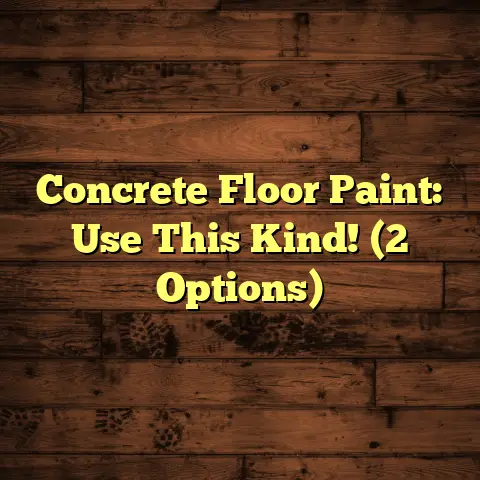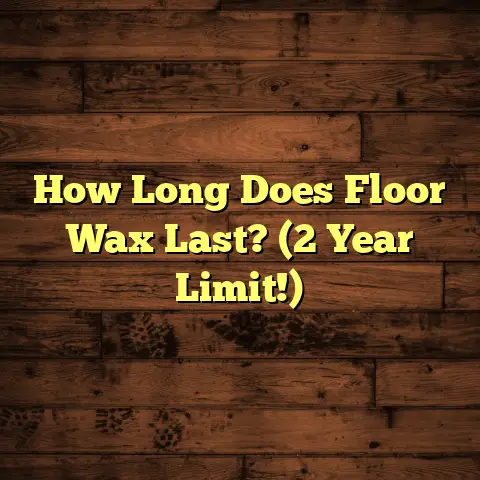Refinish Hardwood: How Often Is Needed? (3 Signs!)
One of the most important things you can do to maintain your hardwood floors is refinishing. Refinishing not only brings back that original luster but also extends the life of your floors, saving you big bucks in the long run compared to a full replacement.
Think of refinishing as giving your floors a fresh start, a chance to shine again. In this article, I’m going to break down everything you need to know about refinishing hardwood floors, including how often you should do it and the telltale signs that it’s time for a refresh. Let’s dive in!
Section 1: Understanding Hardwood Refinishing
Okay, so what exactly is hardwood refinishing? Simply put, it’s the process of sanding down the top layer of your hardwood floors to remove any existing finish, scratches, or imperfections.
Then, we stain the wood (if you want a new color) and apply several coats of a protective sealant. It’s like giving your floors a brand-new skin!
The main steps usually include:
- Sanding: This removes the old finish and any imperfections.
- Staining (Optional): This changes the color of the wood.
- Sealing: This protects the wood from future wear and tear.
Now, let’s talk finishes. There are two main types: oil-based and water-based.
- Oil-based finishes are known for their durability and rich amber hue, but they take longer to dry and have a stronger odor.
- Water-based finishes are more eco-friendly, dry faster, and have a lower odor, but they might not be as durable as oil-based options.
Which one is better? Well, it depends on your priorities. I often recommend water-based finishes for homes with kids or pets because of the lower VOCs (volatile organic compounds).
But for high-traffic areas, an oil-based finish might be the way to go.
And here’s a crucial point: knowing your wood! Different types of hardwood have different characteristics. For example, a softer wood like pine will require more frequent refinishing than a harder wood like oak or maple. Understanding the Janka hardness scale can be really helpful here. The Janka scale measures the relative hardness of different wood species. The higher the number, the harder the wood. Here’s a quick look at some common hardwood species and their Janka ratings:
| Wood Species | Janka Rating |
|---|---|
| Red Oak | 1290 |
| White Oak | 1360 |
| Maple (Hard) | 1450 |
| Hickory | 1820 |
| Brazilian Walnut (Ipe) | 3680 |
| American Cherry | 950 |
| Pine (Southern Yellow) | 870 |
Source: https://www.wood-database.com/
As you can see, Brazilian Walnut is incredibly hard and durable, while pine is much softer and more prone to dents and scratches. Knowing this can help you anticipate how often your floors will need refinishing.
Section 2: How Often Should You Refinish Hardwood Floors?
Alright, let’s get to the million-dollar question: how often should you actually refinish your hardwood floors? Generally speaking, most hardwood floors need refinishing every 7-10 years. But that’s just a guideline!
Think of it like changing the oil in your car – the frequency depends on how you drive it, right?
Several factors can influence how often your floors need refinishing, including:
- Foot Traffic: High-traffic areas like hallways and kitchens will wear down faster.
- Type of Finish: As I mentioned earlier, oil-based finishes tend to be more durable than water-based finishes.
- Pets: Paws and claws can wreak havoc on hardwood floors!
- Kids: Enough said, right?
- Environmental Conditions: Excessive humidity or dryness can damage wood floors.
- Quality of the Original Installation and Finish: A poor installation or a low-quality finish will shorten the lifespan of your floors.
For example, a home with a couple of adults and no pets might only need refinishing every 10-12 years. But a home with a large family, several pets, and lots of foot traffic might need refinishing every 5-7 years.
According to the National Wood Flooring Association (NWFA), a well-maintained hardwood floor can last for generations with proper care and refinishing.
While there isn’t a single magic number for refinishing frequency, paying attention to the signs of wear and tear is crucial. Which leads us to the next section!
Section 3: The Three Key Signs Your Hardwood Floors Need Refinishing
Okay, let’s get down to business. Here are the three key signs that your hardwood floors are screaming for a refinishing:
1. Sign 1: Visible Scratches and Dents
This one’s pretty obvious, right? Over time, everyday wear and tear can lead to scratches and dents on your hardwood floors.
A few minor scratches are normal, but when they start to accumulate and become noticeable, it’s time to consider refinishing.
How do you know when it’s “too many” scratches? Well, take a good look at your floors in different lighting conditions.
If the scratches are catching the light and making your floors look dull and worn, it’s definitely time.
Think of it this way: those scratches aren’t just cosmetic issues. They’re also weakening the protective finish on your floors, making them more vulnerable to moisture damage and further wear and tear.
And let’s be honest, a scratched-up floor just doesn’t look very appealing. It can detract from the overall aesthetic of your room and make your home feel less inviting.
I’ve seen homes where the scratches were so deep that they had actually penetrated the wood itself! In those cases, refinishing is essential to prevent further damage and restore the integrity of the floor.
2. Sign 2: Fading and Discoloration
Sunlight is a beautiful thing, but it can be a real enemy to hardwood floors. Over time, exposure to UV rays can cause the finish on your floors to fade and discolor.
This is especially noticeable in areas that get a lot of direct sunlight, like near windows or sliding glass doors.
You might notice that the color of your floors is uneven, with some areas looking lighter or more yellowed than others. This uneven coloring is a dead giveaway that refinishing is needed.
Think about it like this: your floors are constantly being exposed to the elements, just like your skin. And just like your skin needs sunscreen to protect it from the sun’s harmful rays, your floors need a protective finish to prevent fading and discoloration.
I once worked on a home where the homeowners had a large area rug in their living room for years. When they finally removed the rug, they were shocked to see how much the floors around the rug had faded compared to the area underneath the rug! The difference was dramatic, and it was clear that refinishing was the only way to restore the uniformity of the floor.
3. Sign 3: Water Damage and Warping
Water is another major threat to hardwood floors. Excessive moisture can cause the wood to warp, buckle, or even rot.
Signs of water damage include:
- Warping: The boards start to curve or bend.
- Buckling: The boards lift up from the subfloor.
- Cupping: The edges of the boards rise up, creating a concave shape.
- Dark Stains: Water stains can penetrate the wood and leave unsightly marks.
- Mold or Mildew: This can grow in damp areas and cause further damage.
If you notice any of these signs, it’s crucial to address the problem immediately. Water damage can quickly spread and cause serious structural issues.
Ignoring water damage can lead to costly repairs down the road. In severe cases, you might even have to replace the entire floor!
I remember one job where the homeowners had a leaky pipe under their kitchen sink for months without realizing it. By the time they discovered the leak, the hardwood floors in the kitchen were severely warped and rotted. We had to completely tear out the old floors and install new ones, which was a much more expensive and time-consuming project than simply refinishing them would have been.
Important Note: If you suspect water damage, it’s essential to identify and fix the source of the moisture before refinishing your floors. Otherwise, the problem will just come back.
Section 4: The Refinishing Process
So, you’ve decided that your hardwood floors need refinishing. Now what? Here’s a quick overview of the refinishing process:
- Preparation: This involves removing all furniture, rugs, and other items from the room. You’ll also need to thoroughly clean the floors to remove any dirt, dust, or debris.
- Sanding: This is the most important step. We use a series of sanding machines with progressively finer grits of sandpaper to remove the old finish and smooth out any imperfections.
- Staining (Optional): If you want to change the color of your floors, we’ll apply a stain after sanding.
- Sealing: Finally, we’ll apply several coats of a protective sealant. This will protect your floors from future wear and tear and give them a beautiful, long-lasting finish.
Now, should you hire a professional or DIY? That’s a tough question.
DIY:
- Pros: Cheaper, you have complete control.
- Cons: Time-consuming, requires specialized equipment, can be messy, and mistakes can be costly.
Hiring a Professional:
- Pros: Faster, more efficient, professional results, less hassle.
- Cons: More expensive.
Honestly, unless you’re very experienced with woodworking and have access to the right equipment, I usually recommend hiring a professional. Refinishing hardwood floors is a skill that takes years to master, and mistakes can be expensive to fix.
For example, if you sand too aggressively, you can damage the wood and create an uneven surface. And if you apply the finish incorrectly, you can end up with streaks, bubbles, or other imperfections.
Here are some essential tools and materials for refinishing hardwood floors:
- Sanding Machines: Drum sander, edger sander, orbital sander
- Sandpaper: Various grits, from coarse to fine
- Stain (Optional): Choose a color that complements your home’s décor.
- Sealer: Polyurethane, varnish, or other protective finish
- Applicators: Brushes, rollers, or pads
- Safety Gear: Dust mask, eye protection, ear protection
Tips for a Successful Outcome:
- Take Your Time: Don’t rush the process.
- Sand Evenly: Avoid creating dips or ridges in the wood.
- Apply Thin Coats of Finish: Multiple thin coats are better than one thick coat.
- Allow Each Coat to Dry Completely: Follow the manufacturer’s instructions.
- Ventilate the Room: This will help the finish dry faster and reduce fumes.
Conclusion
So, there you have it! Everything you need to know about refinishing hardwood floors. Remember, refinishing is an essential part of maintaining your floors and preserving their beauty and value.
Keep an eye out for those three key signs: visible scratches and dents, fading and discoloration, and water damage and warping.
By addressing these issues promptly, you can prevent further damage and keep your floors looking their best for years to come.
Don’t wait until your floors are in complete disrepair before taking action. Regular maintenance and timely refinishing will save you money in the long run and ensure that your hardwood floors remain a beautiful and valuable asset to your home.
Now, take a look at your own hardwood floors. Do you see any of the signs I’ve mentioned? If so, it might be time to consider scheduling a refinishing. Trust me, your floors (and your wallet) will thank you!





